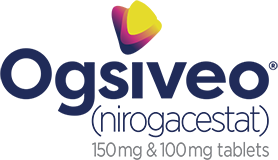Facts & Stats on Desmoid Tumors
Knowledge of desmoid tumors may help you make informed decisions with your doctor.
Desmoid tumors are dense, soft-tissue tumors. They can grow aggressively and affect nearby tissues and organs. They can often return, even after surgery or other treatments. A desmoid tumor is also called aggressive fibromatosis. Only 3% of soft tissue tumors are desmoid tumors. It is a rare tumor type.1-4
In the US, up to 1650 people are diagnosed with desmoid tumors every year.5-7
Women are more likely to be diagnosed with desmoid tumors, but men are at risk as well6,8,9
The majority of people with desmoid tumors are diagnosed in young adulthood6
After surgery, desmoid tumors may come back—based on the tumor location and other factors9,10
Desmoid tumors can affect each person differently depending on where the tumor is in the body, how fast it grows, and other factors.

The risk of desmoid tumors rises for people with a family history of familial adenomatous polyposis (FAP).11 If a person has FAP, doctors may recommend a colectomy to help prevent colon cancer. However, for some, this surgery can increase the risk of developing desmoid tumors.4

Desmoid tumors can develop anywhere in the body where there is soft connective tissue.2 For example: tumors may form in tissues inside the abdomen (intra-abdominal), the chest, legs and feet, arms and hands, or the head and neck.4

Desmoid tumors do not spread to other parts of the body (metastasize). Although they are not malignant, they can cause serious health problems as they grow. They can affect and damage surrounding organs, blood vessels, and nerves.1,2

Desmoid tumor symptoms can vary based on where the tumor is located. For example: A tumor within the abdominal area may cause digestive system blockages, pain, malaise, abdominal swelling, weight loss, or muscle wasting.4,12,13 Tumors in the arms or legs may cause limited movement, deformity, pain, tiredness, weakness or muscle problems.4,14,15
Identifying progression
It’s important to know if your tumor is progressing, or getting worse.16 Signs of progression may include:
- Changes in imaging tests. The tumor may appear bigger on a CT scan or MRI17
- New or changing symptoms. You may experience new symptoms, or your existing symptoms may worsen17
Regularly monitoring your symptoms and reporting them to your healthcare providers may help them create a more personalized treatment plan.
How can I track my symptoms?
The OGSIVEO Treatment Tracker is available to help track your symptoms.
There are also various health apps you can use to keep track of your symptoms on your smart phone such as Apple Health™. WebMD® also offers a tracking feature called Symptom Checker.
These applications are provided for informational purposes only and do not represent an endorsement or a recommendation from SpringWorks Therapeutics, Inc. The applications listed are independent of SpringWorks and SpringWorks has no control over the content of these applications. The applications are linked to other websites that have different terms of use and privacy policies. Please refer to those applications and websites for the applicable terms of use and privacy policies.
How are desmoid tumors diagnosed?
Your doctor may perform a physical exam and ask about your medical and family history.
These tests can also help with diagnosis:
- Biopsy: Typically, a tiny sample of the tumor tissue is taken out with a needle and analyzed by a pathologist to confirm if it is a desmoid tumor17,18
- Imaging Scans (CT or MRI17,18 ) can also help your doctor see the location and size of the tumor19
Can desmoid tumors be mistaken for other medical conditions?
Because they are so rare, desmoid tumors may sometimes be misdiagnosed as:8,20
- Hypertrophic scars or keloids
- Low-grade sarcomas or gastrointestinal stromal tumor (GIST)
- Benign growths such as nodular fasciitis, lipoma, fibroma, schwannoma, or leiomyoma
Which healthcare professionals can help with treating or managing desmoid tumors?
Your care team may include desmoid tumor specialists, such as:21,22
- Medical oncologist
- Surgeon, orthopedic or surgical oncologist
- Radiation oncologist
- Pathologist
Your care team may also include nurses, nurse practitioners, and physician assistants.
Mental health and other healthcare professionals may also be involved in your care.22
If a local desmoid tumor specialist isn’t available, they may still be able to collaborate with a local community oncologist to manage your care closer to home.21
A multidisciplinary care team can help you:23
- Decide on your individualized care plan based on the advice of multiple healthcare professionals, including a desmoid tumor specialist or expert
- Coordinate your care for a faster time to treatment
- Use the team’s shared knowledge to help make informed treatment decisions
Where can I learn more about desmoid tumors?
You may ask your doctor or care team for additional information. Explore online resources through advocacy groups and communities focused on desmoid tumor education, including:
- The Desmoid Tumor Research Foundation (DTRF)
- Rein In Sarcoma
- National Organization for Rare Disorders (NORD)
- Sarcoma Alliance for Research through Collaboration (SARC)
- Sarcoma Foundation of America (SFA)
- Northwest Sarcoma Foundation
- Global Genes
For more information, the National Comprehensive Cancer Network® (NCCN®) also has helpful resources, including the NCCN Guidelines for Patients®: Soft Tissue Sarcoma.
SpringWorks Therapeutics, Inc. is providing these links to help patients find more information about desmoid tumors, but inclusion on this list does not represent an endorsement or a recommendation from SpringWorks for any group or organization. The organizations listed are independent of SpringWorks Therapeutics.
Advocacy Groups
SpringWorks Therapeutics, Inc. is providing these links to help patients find more information about desmoid tumors, but inclusion on this list does not represent an endorsement or a recommendation from SpringWorks for any group or organization. The organizations listed are independent of SpringWorks Therapeutics.












